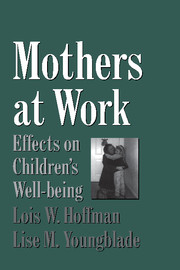Book contents
- Frontmatter
- Contents
- Preface
- 1 Introduction and Review of the Literature
- 2 Methodology
- 3 Children's Daily Family Lives: The After-School Day Interview
- 4 The Husband–Wife Relationship
- 5 The Mother's Well-being
- 6 Childrearing
- 7 Maternal Employment and Child Outcomes: The Direct Relationships
- 8 The Father's Role, Gender Attitudes, and Academic Outcomes
- 9 The Mother's Well-being and Child Outcomes
- 10 Childrearing Patterns and Child Outcomes
- 11 Nonmaternal Care and Supervision: Prevalence and Effects of Child-care Arrangements on Child Well-being
- 12 Summary and Overview
- Appendix: Measures Developed for This Study
- References
- Author Index
- Subject Index
1 - Introduction and Review of the Literature
Published online by Cambridge University Press: 06 July 2010
- Frontmatter
- Contents
- Preface
- 1 Introduction and Review of the Literature
- 2 Methodology
- 3 Children's Daily Family Lives: The After-School Day Interview
- 4 The Husband–Wife Relationship
- 5 The Mother's Well-being
- 6 Childrearing
- 7 Maternal Employment and Child Outcomes: The Direct Relationships
- 8 The Father's Role, Gender Attitudes, and Academic Outcomes
- 9 The Mother's Well-being and Child Outcomes
- 10 Childrearing Patterns and Child Outcomes
- 11 Nonmaternal Care and Supervision: Prevalence and Effects of Child-care Arrangements on Child Well-being
- 12 Summary and Overview
- Appendix: Measures Developed for This Study
- References
- Author Index
- Subject Index
Summary
Introduction
This book examines the effects of the mother's employment on family life and children's well-being. It starts with a review of the previous research and then reports the results of a study designed to answer the questions that emerge. The study focuses on 369 families with a child in the third or fourth grades of the public schools in an industrialized city in the Midwest. They represent a broad socioeconomic range and include both one-parent and two-parent families, African Americans and Whites. Extensive data have been obtained from mothers, fathers, children, teachers, classroom peers, and school records. The guiding hypothesis that emerges from the review of previous research is that maternal employment has few, if any, direct effects on the child; it operates mainly through the effect on the family. Three aspects of family life seem particularly important in mediating child effects: the role of the father, the mother's sense of well-being, and the parents' childrearing attitudes and behaviors. The data analyses reported here trace each of these links and reveal how the mother's employment affects family life and, by that route, affects child outcomes.
The book is divided into three parts. The first includes a review of the previous research and a description of the study. The second reports the results of the analyses that examine how the mother's employment status affects the father's role in the family, the mother's sense of well-being, and childrearing patterns.
- Type
- Chapter
- Information
- Mothers at WorkEffects on Children's Well-Being, pp. 1 - 28Publisher: Cambridge University PressPrint publication year: 1999



